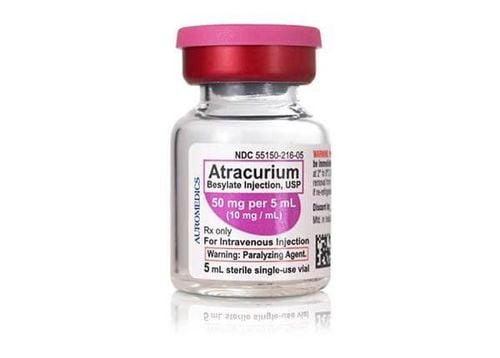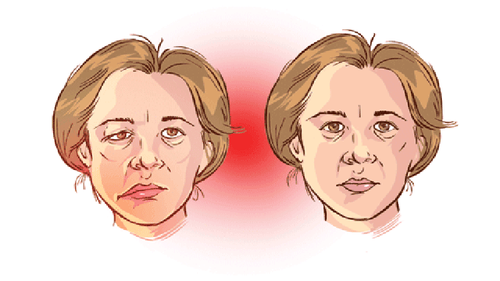This is an automatically translated article.
Myasthenia gravis is associated with muscle weakness and easy fatigue. This condition can be diagnosed through blood tests, electromyography, and sometimes edrophonium. Many patients worry whether myasthenia gravis is dangerous? Check out the article below!
1. What is myasthenia gravis?
Myasthenia gravis occurs when the immune system, which is the body's defense against germs, produces antibodies that disrupt nerve signals. As a result, your muscles become weaker. This condition cannot be completely cured, but your doctor will help you manage your symptoms. Symptoms usually first appear in the muscles of the eye, then all skeletal muscles (also called voluntary muscles) are affected, such as the muscles that move your legs and arms, and the muscles that help you breathe. .
2. Symptoms of myasthenia gravis
Eyelid ptosis is the most common symptom of myasthenia gravis. This disease weakens the small and fragile muscles around the eyes, making it difficult to open them completely. You may also have difficulty controlling your eyelid movements and focusing on objects, causing blurred or double vision (double vision). If only myasthenia gravis is present, the other muscles will not be affected.
Face and throat Myasthenia gravis also commonly affects the muscles in the face and throat, causing your face to appear abnormal. For example, your face may look like it's grimacing if you try to smile. You may have trouble holding your head up or speaking. Some people have difficulty chewing and swallowing, as well as drooling or choking.
Breathing problems When myasthenia gravis weakens the muscles around the chest cavity, you may find it harder to breathe. Stress, infections, and even certain medications can cause a person to need special equipment to breathe. To limit your risk of this rather dangerous condition, tell your doctor right away if you notice any problems with your breathing.
Arms and legs When you have myasthenia gravis, the degree of muscle weakness will depend on your activity level and factors such as: stress, diet and overall health. At certain times, weak arms and legs can make it difficult to lift objects, climb stairs, or even stand up. The way the patient walks also looks different than usual. These symptoms may improve with rest.
Thymus problems Some people with myasthenia gravis have a larger than normal thymus gland in their chest. This organ is part of the immune system. The patient may also have a tumor in the thymus. Most cases are benign, but can sometimes become cancerous.

Nguyên nhân bệnh nhược cơ có thể gây ra bởi một số yếu tố khác nhau
3. Causes of myasthenia gravis
Myasthenia gravis is an autoimmune disease, meaning your immune system mistakenly attacks your own body tissues. Scientists believe that genetics play an important role in the pathogenesis. Research is still ongoing to better understand which specific genes cause myasthenia gravis.
Certain factors can make myasthenia gravis symptoms worse, such as:
Illness Stress or fatigue Pregnancy or menstrual cycle Certain medications, such as: Blockers beta, quinidine gluconate, quinine, quinidine sulfate, phenytoin, some anesthetics and antibiotics. It occurs most commonly in women under 40 and men over 60, but people are at risk at any age, including in childhood. Although rare in newborns, there are cases where a mother with myasthenia gravis passes on the antibodies that cause the disease to her baby. Neonatal myasthenia gravis is usually not serious and symptoms go away on their own around 3 months after birth.
4. Diagnosis
Your doctor will review your medical history and examine your body, for example, looking at muscle strength and coordination, as well as eye movements. Because muscle weakness is a common symptom of many different diseases, it can take a long time (at most 2 years) for a doctor to make a full diagnosis. This is especially true for mild cases or symptoms that affect only a few muscles.
Some other ways to diagnose the disease include:
Trial treatment of intravenous edrophonium, in which you will take a medicine to reduce eye problems and the doctor watches your response. Blood tests can check levels of certain antibodies. An electrical stimulation (electromyography) test checks the signal from the nerve to the muscle, which shows how responsive the muscle is. A CT or MRI scan helps to see if the thymus gland is larger than normal or for the presence of tumors. Lung tests can help doctors predict myasthenia gravis.

Sau khi chụp CT phần nào quyết định được bệnh nhược cơ có nguy hiểm không của bệnh nhân
5. Treatment of myasthenia gravis
5.1. Surgery If you have one or more tumors on your thymus, your doctor may recommend surgery to remove them. This approach improves symptoms and reduces the need for medication. This method will also be useful even if there is no tumor, but it will take several years to see results. Open surgery that goes through the sternum is a common option, but less invasive options may also be available for some people.
5.2. Medications Your doctor may suggest you take:
Anticholinesterase medications to improve nerve signal transmission to the muscles. Immunosuppressive drugs to slow or stop the production of harmful antibodies, thereby improving muscle strength. 5.3. Intravenous (IV) therapy Doctors often order more or more blood and medicine to be injected through a brachial vein when symptoms suddenly get worse. Specifically:
Plasma separation (Plasmapheresis) helps to remove harmful antibodies and replace with good plasma. Intravenous immunoglobulin gives you normal antibodies to change the way your immune system works. Monoclonal antibodies are drugs that are given intravenously and are usually only used after other treatments have failed.
6. Is myasthenia gravis dangerous?
If you take your medicine regularly and follow your doctor's instructions, you can improve your muscle weakness and lead a near-normal life. In some cases, the symptoms can go away completely and you don't need to take the medicine anymore. About half of people with myasthenia gravis who undergo thymectomy experience long-term remission.
Vinmec International General Hospital currently has modern methods of diagnosing myasthenia gravis, performed by a team of highly qualified and experienced medical doctors, with a complete and advanced medical equipment system that will for accurate diagnosis of myasthenia gravis.
Please dial HOTLINE for more information or register for an appointment HERE. Download MyVinmec app to make appointments faster and to manage your bookings easily.
Reference source: webmd













